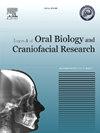Reduction in tongue space/tongue volume ratio as a risk factor for oral tongue squamous cell carcinoma-an exploratory study
Q1 Medicine
Journal of oral biology and craniofacial research
Pub Date : 2025-04-23
DOI:10.1016/j.jobcr.2025.04.002
引用次数: 0
Abstract
Background
The occurrence of tongue cancers in young adults with no associated habitual risk factors is emerging as a major health concern. The objective of the study was to investigate the role of low tongue space-tongue volume ratio as a risk factor for oral tongue squamous cell carcinoma.
Methods
A case control study was conducted among histopathologically confirmed cases of squamous cell carcinoma of lateral border of the tongue who underwent treatment at the Department of Head & Neck Surgery (case group, n = 50). The patients with normal tongue referred for the evaluation of Magnetic Resonance Imaging of head region for other ailments formed the control group (n = 50). The space available for the tongue and the tongue volume of the study population were measured from the Magnetic Resonance Images (MRI), using in built software, and the mean Tongue space/Tongue volume ratio (TS/TV) of both the case group and the control group were calculated. A comparison of the TS/TV ratio was made between the test group and the control group using independent two sample t-test. The cut off value for TS/TV ratio between the groups was determined using Receiver Operating Characteristic (ROC) Curve method and Odds ratio was calculated by grouping the study population as low or high TS/TV ratio group using the cut off value obtained.
Results
A statistically significant variation was observed in the TS/TV ratio between tongue cancer patients and the normal controls with the mean value in normal controls higher than tongue cancer patients (p value = 0.009). The cut off value for TS/TV ratio for the development of tongue cancer was determined as 1.259 using ROC curve and the Odds ratio for malignant transformation in patients with low TS-TV ratio was calculated as 2.6.
Conclusion
A significant difference in TS/TV ratio between cases & normal controls observed in our study indicated that a lack of available space for the tongue either due to increase in tongue volume or decrease in tongue space may predispose an individual for the development of tongue cancer.

舌间距/舌体积比减小是口腔舌鳞状细胞癌的危险因素——一项探索性研究
背景舌癌在没有相关习惯危险因素的年轻成人中发生正成为一个主要的健康问题。本研究的目的是探讨低舌空-舌体积比作为口腔舌鳞状细胞癌的危险因素的作用。方法对经组织病理学证实的舌侧缘鳞状细胞癌患者进行病例对照研究。颈部外科(病例组,n = 50)。对照组50例,舌部正常,用于评估头部区域磁共振成像的其他疾病。使用内置软件通过磁共振成像(MRI)测量研究人群的舌头可用空间和舌头体积,并计算病例组和对照组的平均舌头空间/舌头体积比(TS/TV)。采用独立双样本t检验比较试验组与对照组的TS/TV比值。采用受试者工作特征(Receiver Operating Characteristic, ROC)曲线法确定各组间TS/TV比的截断值,并根据所得的截断值将研究人群分为TS/TV比低组和高组,计算比值比。结果舌癌患者与正常对照组TS/TV比值差异有统计学意义,正常对照组TS/TV均值高于舌癌患者(p值= 0.009)。采用ROC曲线确定TS/TV比发生舌癌的截断值为1.259,计算TS-TV比低的患者发生恶性转化的比值比为2.6。结论两组患者TS/TV比值差异有统计学意义;在我们的研究中观察到的正常对照表明,由于舌头体积的增加或舌头空间的减少而导致的舌头可用空间的缺乏可能使个体易患舌癌。
本文章由计算机程序翻译,如有差异,请以英文原文为准。
求助全文
约1分钟内获得全文
求助全文
来源期刊

Journal of oral biology and craniofacial research
Medicine-Otorhinolaryngology
CiteScore
4.90
自引率
0.00%
发文量
133
审稿时长
167 days
期刊介绍:
Journal of Oral Biology and Craniofacial Research (JOBCR)is the official journal of the Craniofacial Research Foundation (CRF). The journal aims to provide a common platform for both clinical and translational research and to promote interdisciplinary sciences in craniofacial region. JOBCR publishes content that includes diseases, injuries and defects in the head, neck, face, jaws and the hard and soft tissues of the mouth and jaws and face region; diagnosis and medical management of diseases specific to the orofacial tissues and of oral manifestations of systemic diseases; studies on identifying populations at risk of oral disease or in need of specific care, and comparing regional, environmental, social, and access similarities and differences in dental care between populations; diseases of the mouth and related structures like salivary glands, temporomandibular joints, facial muscles and perioral skin; biomedical engineering, tissue engineering and stem cells. The journal publishes reviews, commentaries, peer-reviewed original research articles, short communication, and case reports.
 求助内容:
求助内容: 应助结果提醒方式:
应助结果提醒方式:


